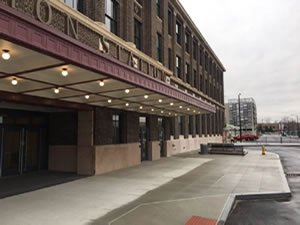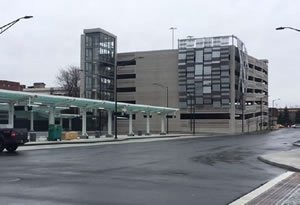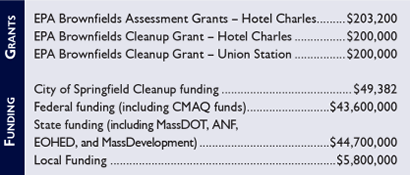R1 Success Story: Union Station, Springfield, Mass.

EPA Grant Recipient:
City of Springfield
Grant Types:
Assessment, Cleanup
Former Uses:
Transit Station
Current Use:
Transit Station including restaurants and newsstands
Download Success Story:
Union Station Springfield, Mass. (pdf)
Originally constructed in 1926, Union Station was a major transportation hub that at one time saw more than 130 passenger trains and 100 mail trains a day. The station, fondly remembered by older Springfield residents as a hub of activity, has been revitalized with the help of Brownfields cleanup and City redevelopment funding. The adjacent Hotel Charles property, which was also cleaned up with a Brownfields grant, has been repurposed into a parking garage for the redeveloped Union Station. The Springfield Redevelopment Authority sought to redevelop both properties in order to consolidate the Pioneer Valley Transportation Authority (PVTA), commuter rail, Amtrak, and intercity bus operations into one hub.
Priming the Property for Redevelopment
Union Station was built to accommodate higher demand for trains in the greater Springfield region. The original station had a three-story terminal and a two-story baggage claim. Older residents of Springfield still recall visiting the station to see family, go to the bustling businesses nearby, or travel out of the city. The station notably served to welcome and send off soldiers serving in World War II. In later years, the demographic served by Union Station shrank as people moved away from city centers and personal vehicles became more popular. Union Station closed in 1973, and the vacant property was taken by eminent domain by the Springfield Redevelopment Authority in 1989.

Redevelopment began on Union Station in late 2012, with the bulk of the construction activity completed during the winter of 2016/2017 and a grand opening event in June 2017.
"Union Station's redevelopment, after over four decades of closure, has been a beacon for the City of Springfield. Winning the 2017 National Phoenix Award was a tribute to a partnership that could see the potential and stayed dedicated to the mission. The City of Springfield, Springfield Redevelopment Authority, MassDevelopment, the Environmental Protection Agency, and the leadership of Congressman Richard E. Neal were all essential in seeing through this complex brownfields redevelopment of our historic train station. We thank them all for their efforts and today enjoy the spoils of that work with our state-of-the-art multimodal transit facility."
Mayor Domenic J. Sarno
City of Springfield
Today
The new station is now home to Amtrak, commuter trains, the Pioneer Valley Transit Authority, and intercity busses. In addition to the transit authorities that will use the station, the retail space inside includes restaurants and newsstands. According to the City of Springfield, Union Station has the potential to leverage 500-1000 permanent jobs. This collaboration between several state, local, and federal agencies enabled Union Station to rise again as a premier multimodal transportation center in the heart of Springfield.


For more information:
Visit the EPA Brownfields website at www.epa.gov/brownfields or contact Dorrie Paar, 617-918-1432, paar.dorrie@epa.gov.
EPA 560-A-19-007
Updated March 2023
